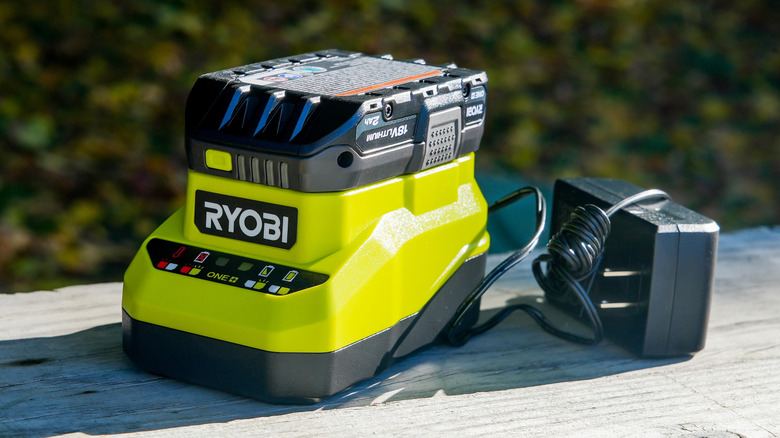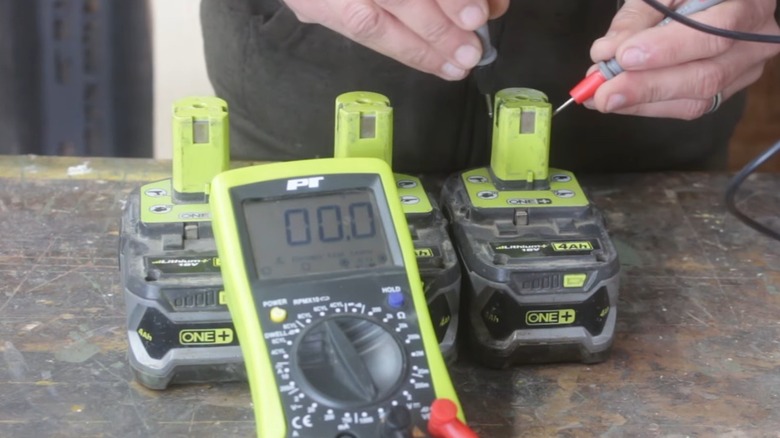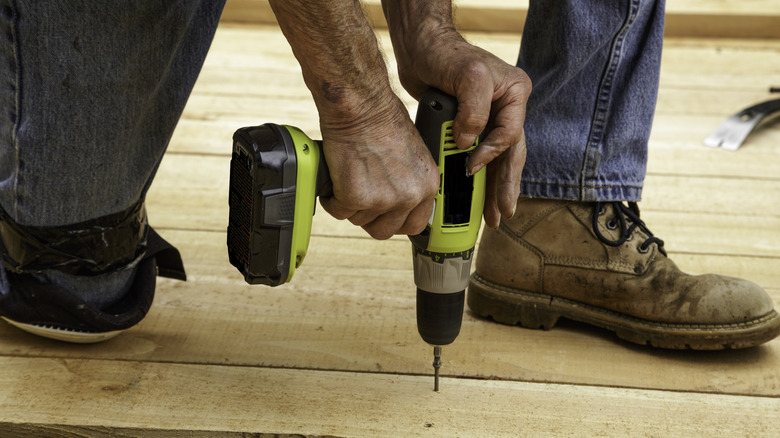How Long Do Ryobi Batteries Really Last? Here's What We Know
When weighing the pros and cons of corded versus cordless power tools, many people opt for cordless models. Are corded tools even worth buying over cordless tools? Cordless models offer a mobility option, where you can carry and use them almost anywhere, which is a significant advantage. On the other hand, corded models tend to deliver more power for tough jobs, and, of course, you don't have to worry about running out of electricity in the middle of a job.
Another disadvantage people may not think about during the initial purchase of cordless models is the upfront cost of batteries and chargers, as well as the eventual replacement cost of batteries. One of the best-ranked cordless tool brands, Ryobi, charges anywhere from about $45 to $300 for a replacement battery, depending on voltage and overall storage capacity. Considering you might pay around $50 for a Ryobi cordless drill for the tool only, the battery's cost is a significant percentage of owning cordless tools.
Ideally, you want to ensure the longevity of your Ryobi tool batteries, guaranteeing you receive the greatest value out of your investment. How long should Ryobi batteries last before needing replacement? Ryobi 18V and 40V batteries both carry a three-year limited warranty from the manufacturer, while an 80V battery has a five-year warranty. However, you could receive six-plus years of longevity when you take care of them properly. Making mistakes in maintenance and care could leave you with two or fewer years of longevity. Learn about the factors that affect Ryobi battery longevity.
Why cordless tool batteries have a limited lifespan
Cordless, rechargeable batteries have a limited lifespan. They eventually suffer from cyclic degradation. Every time the battery goes through a cycle of powering up on the charger and discharging on the tool, it loses a little bit of its capacity. The chemical reaction between the ions and the electrolyte solution that stores power becomes less capable as cyclic degradation occurs. Such issues may not be noticeable at first, but you'll eventually notice reduced performance over time, which can affect the unit's lifespan.
Calendar aging is another reason the battery has a limited lifespan. Regardless of how often you use the battery, the chemicals inside the unit begin to degrade over time. A film called solid electrolyte interphase (SEI) forms inside the unit, which reduces the effectiveness of the chemical reaction.
Another problem that could shorten lifespan is storing and charging the battery in extreme temperatures. Charging in freezing temperatures or lower can cause lithium plating. When lithium builds up on the battery's anode, it potentially shortens the lifespan. Storing the batteries in an area with no temperature control in the summer, such as a garage or shed, can also shorten their lifespan due to degradation. One Reddit user discovered this the hard way, as the user reported receiving only 1.5 to 2 years of lifespan from Ryobi batteries. After telling other Reddit users, "sometimes, it can get around 95 degrees where they are kept," several other Reddit users mentioned the need to store them in a climate-controlled area.
Best practices to protect the lifespan of rechargeable batteries
So, what should you do with your Ryobi rechargeable batteries to ensure you receive as many years of life out of them as possible? Several Reddit users report they have received several years of performance from their Ryobi batteries by using them carefully. One user mentions receiving more than 15 years of performance from several different Ryobi batteries. Another Reddit user agrees: "I've had a few go bad, but not until they were at least five years old. I have a couple [more than 10 years old] that still work fine."
Battery manufacturers estimate the lifespan of their units in terms of charging cycles, which occur each time you put the battery on the charger. The majority of batteries should have between 1,000 and 2,000 cycles before they fail entirely. If you use the battery and charge it every day for three years, you'd have more than 1,000 cycles. To minimize cycles, refrain from using the tool for a few minutes and then charge it again. Along those same lines, don't let it run out of power completely before charging it, as this could damage it. Run the battery until you feel a slight degradation in the tool's performance, and then charge it.
Ryobi recommends storing the battery in a cool, dry place and out of direct sunlight. Don't leave it on the charger after it receives a full charge, as this may shorten its lifespan.


